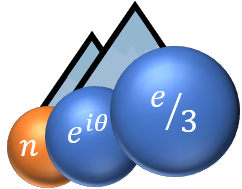In three-dimensional space, elementary particles are divided between fermions and bosons according to the properties of symmetry of the wave function describing the state of the system when two particles are exchanged. The situation is different in two-dimensional systems which can host exotic quasiparticles, called anyons, which obey intermediate quantum statistics characterized by an exchange phase varying between and [1,2]. As a consequence, contrary to fermions and bosons, anyons keep a robust memory of braiding operations, which consist in moving one anyon around another one.
In the fractional quantum Hall regime, obtained by applying a strong magnetic field perpendicular to a two-dimensional electron gas, elementary excitations carry a fractional charge [3,4] and have been predicted to obey fractional statistics [1,2] with an exchange phase (where is an odd integer). I will present how fractional statistics of anyons can be demonstrated in this system by implementing and studying anyon collisions at a beam-splitter [5,6]. In the low magnetic field regime, where the elementary excitations are electrons obeying fermionic statistics, fermion antibunching shows up as a suppression of the current cross-correlations at the output of the beam-splitter, reflecting the fact that two electrons systematically exit in two different arms of the beam-splitter. In the case of anyons in the fractional quantum Hall regime, specfic anyon bunching mechanisms occur, which are directly sensititve to the anyon braiding phase [5,7]. They result in the observation of strong negative cross-correlations of the electrical currents at the output of the beam-splitter that can be used to discriminate between dfferent varieties of anyons with different fractional statistics. The presentation will review experimental investigations of anyons at the filling factors and of the fractional quantum Hall regime [6,8].
[1] B. I. Halperin, Phys. Rev. Lett. 52, 1583–1586 (1984).
[2] D. Arovas, J. R. Schrieffer, F. Wilczek, Phys. Rev. Lett. 53, 722–723 (1984).
[3] R. de Picciotto et al., Nature 389, 162–164 (1997).
[4] L. Saminadayar, D. C. Glattli, Y. Jin, B. Etienne, Phys. Rev. Lett. 79, 2526–2529 (1997)
[5] B. Rosenow, I. P. Levkivskyi, B. I. Halperin, Phys. Rev. Lett. 116, 156802 (2016).
[6] H. Bartolomei et al. Science 368, 173-177 (2020).
[7] Lee, JY.M., Sim, HS, Nature Communications 13, 6660 (2022).
[8] M. Ruelle et al., Phys. Rev. X 13, 011031 (2023).

 PDF version
PDF version
